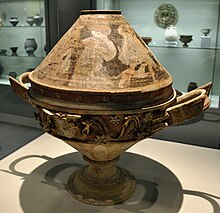Centuripe ware

Centuripe ware, or East Sicilian polychrome ware, or the Centuripe Class of vase, is a type of polychrome Sicilian vase painting from the 3rd and 2nd centuries BC. It is rare, with only some 50 examples known. They have been described, arguably rather unjustly, as "smothered in ornamental colors and shaped too elaborately", an example of Hellenistic "Middle-class taste [that] was often cloying and hideous, sometimes appealing."[1]
The class is named after its first and main find location,
Potting
The vessels are large, measuring about 50 cm (20 in) in height on average. They are composed of separately made segments of orange clay, typically assembled as a single piece, so that lids cannot be lifted. Conversely other pieces, especially of the lekanis shape, are made in several pieces, making them equally impractical for use. Ornamental motifs, dominated by acanthus garlands and architectural friezes, as well as heads and busts, are modelled in three dimensions, usually by moulding, and applied to the surfaces. These probably reflect metalwork, now very rarely surviving, as well as architecture.[5] The Morgantina treasure, found nearby and now returned from New York to Italy, includes good examples of comparable raised decoration in metal from the 3rd century.
Painting

The paintings were only applied on one side, entirely using
The repertoire of figural subjects is limited virtually entirely to women,
With tempera painting, and small pieces of clay ornament projecting from the body, they were far too fragile for any regular use, and it is thought they were either made as

The Metropolitan also has a 3rd-century
Findspots and dating
The finds from Centuripe itself have all apparently come from graves, though most earlier finds were illicitly excavated and so lacked proper archaeological provenances.[18] Conversely, at Morgantina the finds are from temple sanctuaries (for female goddesses), with some fragments from houses.[19]
Broad stylistic considerations always dated them to the 3rd and 2nd centuries BC. There has been considerable debate as to whether the undoubted 3rd-century production continued into the 2nd century. Late 20th-century thinking was that it did not,
-
Centuripe vase in Palermo, 280–220 BC
-
Another vase in Palermo
-
Lekanis with lid and finial, 2nd half of 3rd century BC
Notes
- ^ Cooke, 156
- ^ Stone, 135
- ^ Stone, 136
- ^ Hurwit, 15
- ^ Terracotta lekanis (dish) with lid and finial, Metropolitan Museum of Art
- ^ Von Bothner
- ^ Sparkes, 101
- ^ Stone, 137–138; Sparkes, 101; Stansbury-O'Donnell
- ^ Stone, 137
- ^ Stansbury-O'Donnell; Von Bothner; Mertens
- ^ Hurwit, 15
- ^ Stone, 137–138
- ^ Stansbury-O'Donnell; Von Bothner; Mertens; Metropolitan Museum, New York page; for a vase in poor condition, see the British Museum's best example
- ^ Stansbury-O'Donnell; Stone, 138; Von Bothner; Mertens
- ^ Stone, 138
- ^ "Terracotta lebes gamikos (jar associated with weddings) with lid", Metropolitan object page.
- ^ Centuripe plaque
- ^ Stone, 132
- ^ Stone, 132, 138
- ^ Von Bothner; by and large – Wintermeyer had thought it did.
- ^ Wilson, 97–98; Stone, 136
- ^ Hurwit, 15
References
- Cooke, Tim, The New Cultural Atlas of the Greek World, 2010, Marshall Cavendish, ISBN 0761478787, 9780761478782, google books
- Hurwit, Jeffrey M., "Greek Vases" in Patricia C. Powell (ed), Ancient Etruscan and Greek Vases in the Elvehjem Museum of Art, 2000, Chazen Museum of Art, ISBN 093290047X, 9780932900470, Google books
- Mertens, Joan R., Greece and Rome, pp. 66–67, 1987, Metropolitan Museum of Art, New York, ISBN 0870994441, 9780870994449
- Stansbury-O'Donnell, Mark, A History of Greek Art, p. 374, 2015, John Wiley & Sons, ISBN 1444350145, 9781444350142, google books
- Stone, Shelley C., Morgantina Studies, Volume VI: The Hellenistic and Roman Fine Pottery, 2015, Princeton University Press, ISBN 1400845165, 9781400845163, google books
- Von Bothner, Dietrich, Greek vase painting, p. 67, 1987, Metropolitan Museum of Art (New York, N.Y.)
- Wilson, R.J.A., "Hellenistic Sicily, c. 270–100 BC", in The Hellenistic West: Rethinking the Ancient Mediterranean, Editors: Jonathan R. W. Prag, Josephine Crawley Quinn, 2013, Cambridge University Press, ISBN 1107782929, 9781107782921
- Rolf Hurschmann: Centuripe-Gattung, in Der Neue PaulyVol. 2 (1997), Col. 1069
Further reading
- Deussen, P.W., The Polychromatic Ceramics of Centuripe, 1983, UMI
- Wintermeyer, Ulrike, "Die polychrome Reliefkeramik aus Centuripe", Jdl 90, 1975
External links
- Another example in the MMA, a lekanis
- Example on the art market in 2016, and another
- Example in Toledo, Ohio



